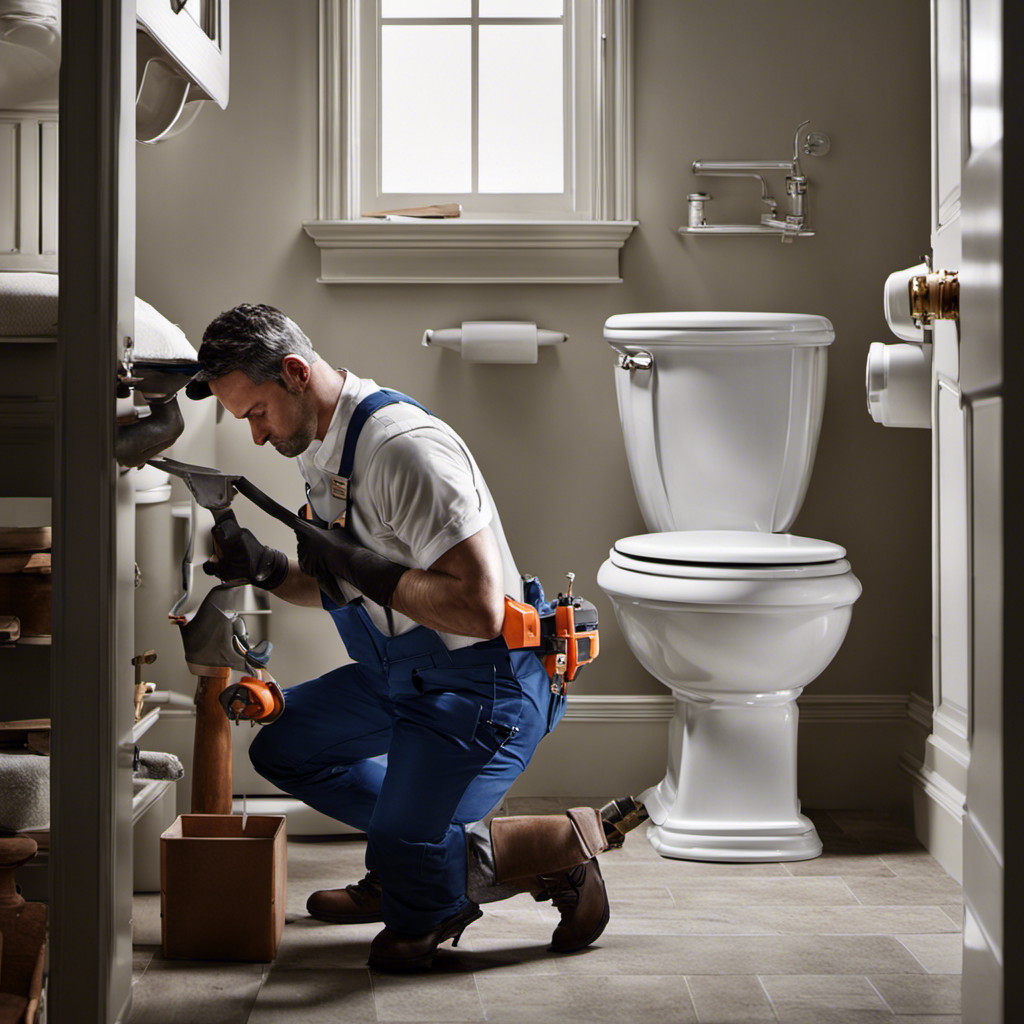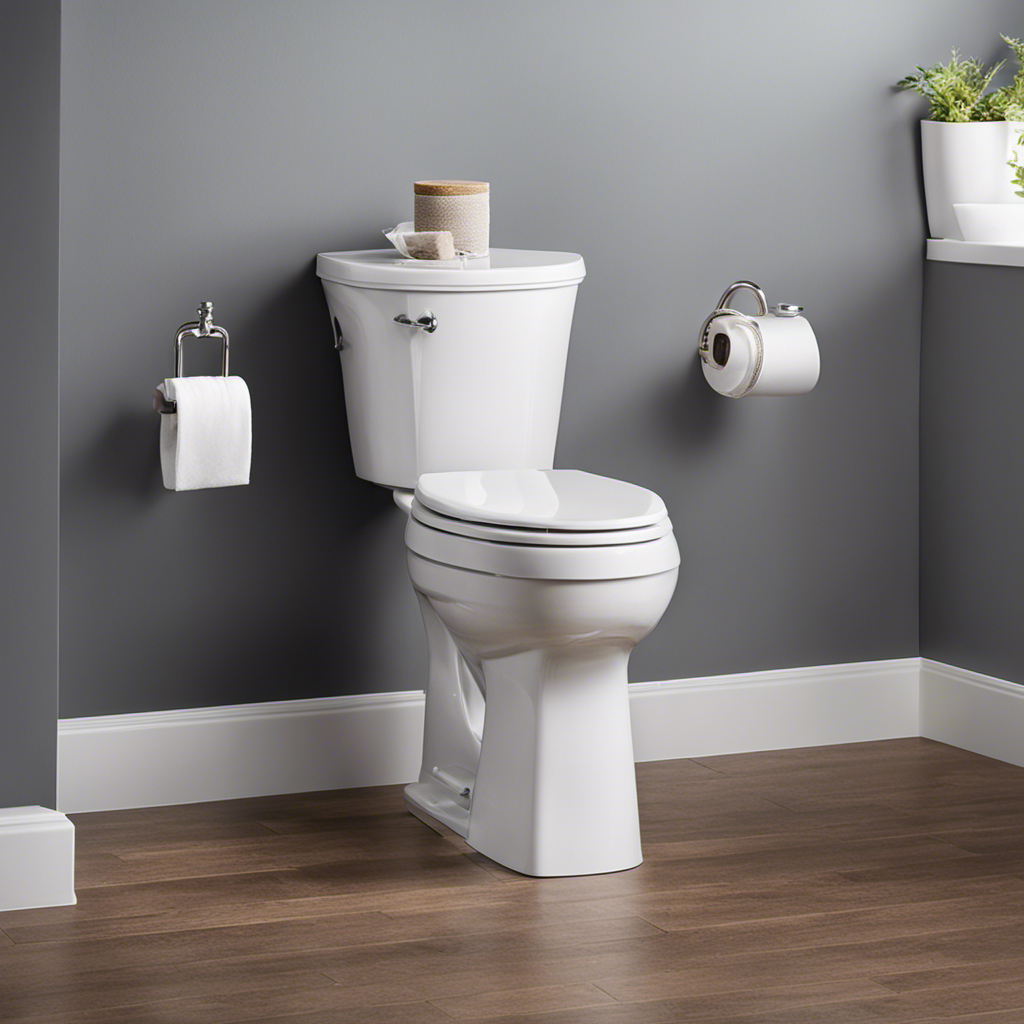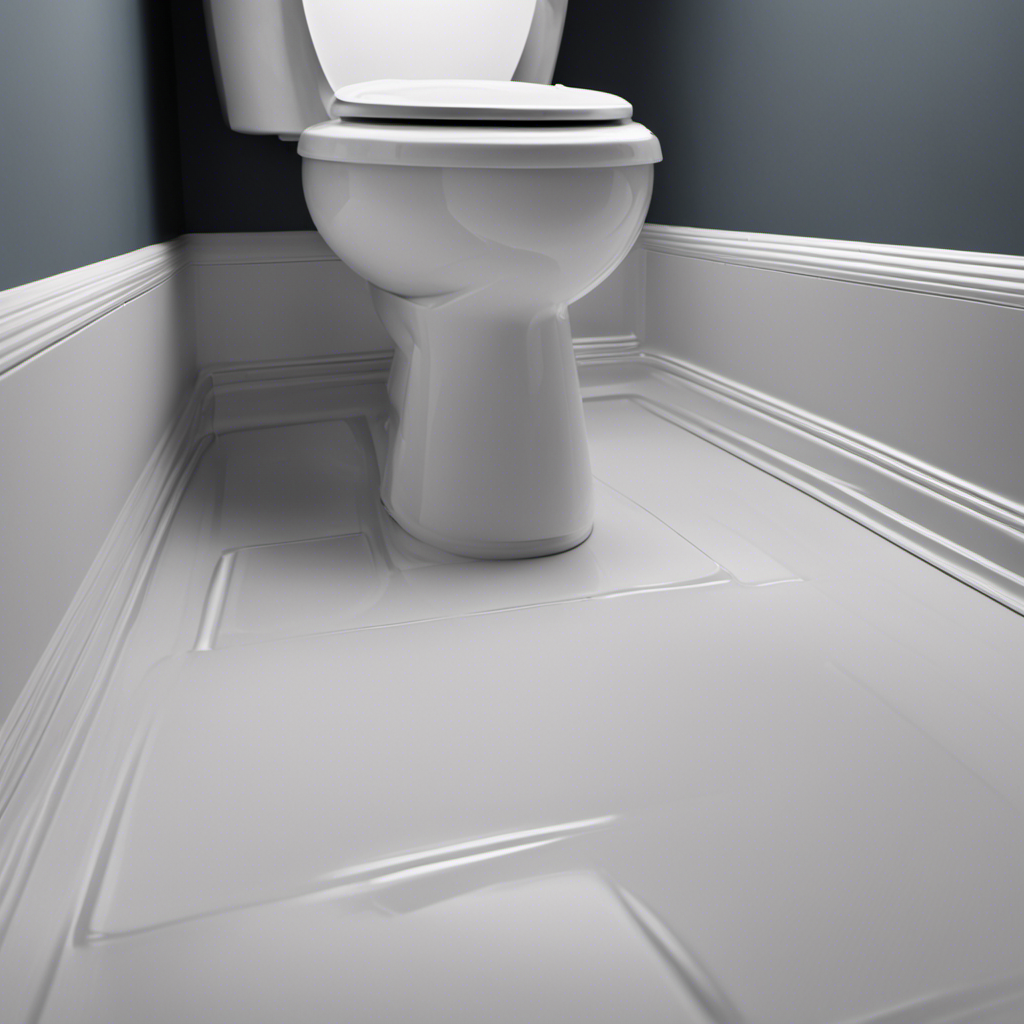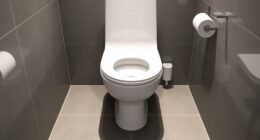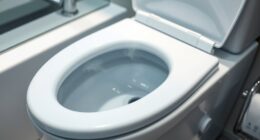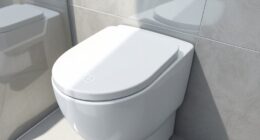Have you ever wondered how much it would cost to replace a toilet? Well, let me tell you, my friend, it’s not as simple as just buying a new one and swapping it out.
There are factors that affect the cost, such as labor and materials.
In this article, I will break down the average cost of toilet replacement and give you some tips for saving money.
So, sit back, relax, and let me guide you through the world of toilet replacement expenses.
Key Takeaways
- The cost of toilet replacement can be influenced by factors such as location, type of toilet chosen, and comparison of prices from different suppliers or retailers.
- Labor costs for toilet replacement typically range from $150 to $300, and it is important to understand the breakdown of material costs and explore alternative options to potentially save on expenses.
- Repairing leaks or cracks, as well as upgrading specific parts of the toilet, can be cost-effective alternatives to full toilet replacement, and the decision between alternatives and replacement depends on factors such as extent of damage and toilet condition.
- Additional expenses to consider for toilet replacement include hidden expenses like installation fees and potential plumbing repairs, as well as the removal cost of the old toilet. It is important to budget for potential hidden costs to avoid financial surprises.
Factors Affecting the Cost of Toilet Replacement
The cost of toilet replacement can vary depending on factors such as location and the type of toilet you choose.
When considering the cost of toilet replacement, it’s important to keep in mind a few cost-saving tips. First, it’s a good idea to shop around and compare prices from different suppliers or retailers.
Secondly, consider the type of toilet you want to install. Basic models are typically more affordable than high-end options.
Additionally, the toilet installation process can also impact the overall cost. If you have basic plumbing skills, you may be able to handle the installation yourself, saving money on labor costs. However, if you’re unsure or uncomfortable with the process, it’s best to hire a professional plumber to ensure proper installation.
Cost of Labor for Toilet Replacement
Labor for toilet replacement can be expensive. The cost of labor can vary depending on various factors, such as location and the complexity of the job. On average, labor costs for toilet replacement range from $150 to $300. However, it’s important to note that this is just an average and the actual cost may vary.
To save on labor costs, there are a few cost-saving tips you can consider. Firstly, you can try to install the toilet yourself if you have the necessary skills and tools. This can help you avoid paying for labor altogether.
Alternatively, you can shop around and compare prices from different plumbers to find the best deal. By doing so, you may be able to find a plumber who offers competitive rates for their services.
Cost of Materials for Toilet Replacement
When it comes to the cost of materials for toilet replacement, it’s essential to understand the breakdown of expenses, explore alternative options, and consider pricing factors.
A material cost breakdown will provide a comprehensive understanding of the different components required for the replacement, such as the toilet bowl, tank, seat, and necessary hardware.
Additionally, exploring alternatives like eco-friendly toilets or different styles can impact both the material and overall cost, while considering pricing factors like brand, quality, and warranties will help in making an informed decision.
Material Cost Breakdown
To get a breakdown of the material costs for replacing a toilet, you’ll need to consider factors like the price of the toilet itself, the cost of any additional parts or fixtures, and any taxes or fees that might apply. The toilet installation process can vary depending on the complexity of the job, but generally involves removing the old toilet, prepping the area, and installing the new toilet. When it comes to cost saving measures, there are a few things you can do. First, consider purchasing a standard or basic toilet instead of a high-end model, as they tend to be more affordable. Additionally, you can save money by reusing existing parts and fixtures if they are still in good condition. Finally, shop around for the best deals and compare prices from different retailers or suppliers.
| Material | Cost |
|---|---|
| Toilet | $150 |
| Wax Ring | $10 |
| Toilet Seat | $30 |
| Supply Line | $20 |
Alternatives and Pricing
If you’re looking for alternatives to replacing your toilet, you might consider options like repairing any leaks or cracks, or upgrading specific parts like the flush handle or fill valve. These alternatives can be more cost-effective compared to a full toilet replacement.
Repairing leaks or cracks can be done by replacing the wax ring or tightening loose connections. Upgrading parts like the flush handle or fill valve can improve the functionality and efficiency of your toilet without the need for a complete overhaul.
The pricing for these alternatives will vary depending on the specific repairs or upgrades needed, but they are generally more affordable than purchasing a new toilet. However, if the damage is extensive or if your toilet is outdated, replacement may be necessary.
In the next section, we will discuss additional expenses to consider for toilet replacement.
Additional Expenses to Consider for Toilet Replacement
There are some extra costs to think about when replacing a toilet. In addition to the cost of the new toilet itself, there are often hidden expenses that can catch homeowners off guard. It’s important to be aware of these additional expenses to avoid any surprises during the replacement process.
One of the most common hidden costs is the installation fee. While some homeowners may feel confident in their DIY skills, hiring a professional plumber is often recommended to ensure proper installation and avoid any potential issues down the line. This can add an extra expense to the overall cost of replacing the toilet.
Another potential additional expense is the need for any repairs or upgrades to the plumbing system. If the existing plumbing is outdated or in need of repairs, it may be necessary to make these fixes before installing the new toilet. This can involve additional materials, labor costs, and potentially even permits depending on the extent of the plumbing work required.
To help you better understand the potential additional expenses when replacing a toilet, here is a table outlining some common costs to consider:
| Additional Expenses | Estimated Cost Range |
|---|---|
| Installation Fee | $100 – $300 |
| Plumbing Repairs | $200 – $500 |
| Permits | $50 – $200 |
| Removal of Old Toilet | $50 – $100 |
| Upgrades to Water Efficiency | $50 – $200 |
It’s important to budget for these potential hidden costs when planning to replace a toilet to ensure a smooth and stress-free process. By being aware of these additional expenses, you can accurately estimate the overall cost of the replacement and avoid any financial surprises.
Average Cost of Toilet Replacement
When it comes to the average cost of toilet replacement, there are several factors that can affect the overall expense. These factors include the type of toilet being installed, the complexity of the installation process, and whether you choose to take on the project as a DIY or hire a professional.
Understanding these key points can help you make an informed decision on how to proceed with your toilet replacement project.
Factors Affecting Cost
To get an accurate estimate for replacing your toilet, you’ll need to consider factors such as the type of toilet, any additional plumbing work needed, and the cost of labor. Here is a breakdown of the cost factors involved in replacing a toilet:
-
Type of toilet: The cost of the toilet itself can vary depending on factors such as brand, design, and features. A basic toilet can range from $100 to $300, while a high-end toilet with advanced features can cost upwards of $500.
-
Additional plumbing work: If there are any issues with the existing plumbing, such as leaks or damaged pipes, these will need to be addressed before the new toilet can be installed. The cost of any necessary repairs or replacements will add to the overall cost.
-
Cost of labor: Hiring a professional plumber to install the new toilet is recommended, as it ensures the job is done correctly. The cost of labor can vary depending on the plumber’s experience and location, but it typically ranges from $150 to $300.
-
Miscellaneous expenses: It’s important to factor in any additional expenses such as permits, disposal fees for the old toilet, and any necessary materials or tools that may be required.
Types of Toilets
One option for a new toilet is a dual-flush toilet. This type of toilet has two flushing options: a half flush for liquid waste and a full flush for solid waste. The installation process for a dual-flush toilet is similar to that of a standard toilet, with the addition of a dual-flush mechanism.
The benefits of a dual-flush toilet include water conservation and cost savings. By using less water for liquid waste, dual-flush toilets can significantly reduce water consumption and lower water bills. Additionally, dual-flush toilets are more environmentally friendly, as they contribute to water conservation efforts.
Overall, choosing a dual-flush toilet can be a smart and sustainable choice for your bathroom.
DIY Vs Professional
If you’re looking to save money, going the DIY route for toilet installation might be worth considering. However, there are some challenges you should be aware of before taking on this project yourself. Here are four things to consider:
-
Plumbing knowledge: Installing a toilet requires a basic understanding of plumbing systems. If you’re not familiar with it, you may encounter difficulties.
-
Tools and materials: DIY installation requires having the right tools and materials on hand, such as a wax ring, bolts, and a wrench. Purchasing these items can add to the overall cost.
-
Time commitment: Installing a toilet can be time-consuming, especially if you’re not experienced. It may take longer than expected, leading to frustration and delays.
-
Potential mistakes: DIY installation can lead to mistakes, such as improper sealing or incorrect alignment. These mistakes can result in leaks or a toilet that doesn’t function properly.
While DIY can save you money, hiring a professional has its advantages. They have the expertise, tools, and experience to ensure a smooth and efficient installation.
Transitioning into the next section on tips for saving money, let’s explore some ways to minimize the cost of toilet replacement.
Tips for Saving Money on Toilet Replacement
There are several ways you can save money on replacing a toilet.
One option is to consider toilet replacement alternatives. Instead of completely replacing the entire toilet, you could try repairing specific parts that are causing issues. For example, if your toilet is constantly running, it might just need a new flapper or fill valve, which are relatively inexpensive to replace.
Another budget-friendly option is to look for discounted or refurbished toilets. Many home improvement stores offer discounted prices on older models or floor samples.
Additionally, you could consider purchasing a water-saving toilet. These toilets are not only environmentally friendly but can also help you save money on your water bill in the long run.
Hiring a Professional Vs. DIY Toilet Replacement
You should consider whether it’s more cost-effective to hire a professional or do the toilet replacement yourself. Here are four key points to help you make an informed decision:
-
DIY Toilet Installation:
- Pros: By doing it yourself, you can save money on labor costs and gain a sense of accomplishment.
- Cons: It requires technical skills, tools, and knowledge of plumbing codes. Mistakes can lead to leaks and costly repairs.
-
Hiring a Professional:
- Pros: Professionals have the expertise and experience to ensure a proper and efficient installation. They can handle any unexpected issues that may arise.
- Cons: It can be more expensive due to labor costs. You may also need to schedule an appointment, which could delay the process.
Ultimately, the decision depends on your comfort level, time availability, and budget. If you’re confident in your skills and have the necessary tools, DIY toilet installation can be a rewarding project. However, if you’re unsure or want to avoid potential complications, hiring a professional is a safer choice.
Frequently Asked Questions
Is It Necessary to Hire a Professional for Toilet Replacement, or Can It Be Done as a DIY Project?
In my experience, it’s possible to replace a toilet as a DIY project, but hiring a professional is recommended. Common mistakes in DIY toilet replacement can lead to leaks or improper installation, which can be costly to fix.
Are There Any Specific Tips for Saving Money on Toilet Replacement?
When it comes to DIY toilet replacement, there are some cost-saving strategies to consider. I can share tips and techniques that will help you save money while successfully replacing your toilet.
What Are Some Additional Expenses to Consider When Replacing a Toilet?
When replacing a toilet, it’s important to consider additional expenses and hidden costs. These can include the cost of hiring a plumber, purchasing new plumbing fixtures, and any necessary repairs to the bathroom floor or walls.
How Much Does Labor Typically Cost for Toilet Replacement?
Labor costs for toilet replacement can vary depending on factors such as location and complexity of the job. Plumbers typically charge a fee for their services, which can range from $100 to $500.
What Factors Can Affect the Cost of Toilet Replacement?
Factors such as the type of toilet, additional plumbing work required, and the region you live in can greatly affect the cost of toilet replacement. It is important to consider these factors when choosing the right toilet for your bathroom.
Conclusion
In conclusion, when it comes to replacing a toilet, the costs can vary depending on various factors such as labor, materials, and additional expenses. It is important to consider these factors and plan your budget accordingly.
While hiring a professional may seem like the easiest option, DIY toilet replacement can be a cost-effective alternative. By following these tips and being aware of the average costs, you can save money and ensure a smooth and efficient toilet replacement process.
So, don’t flush away your hard-earned cash, make a wise decision and give your bathroom a fresh start!
